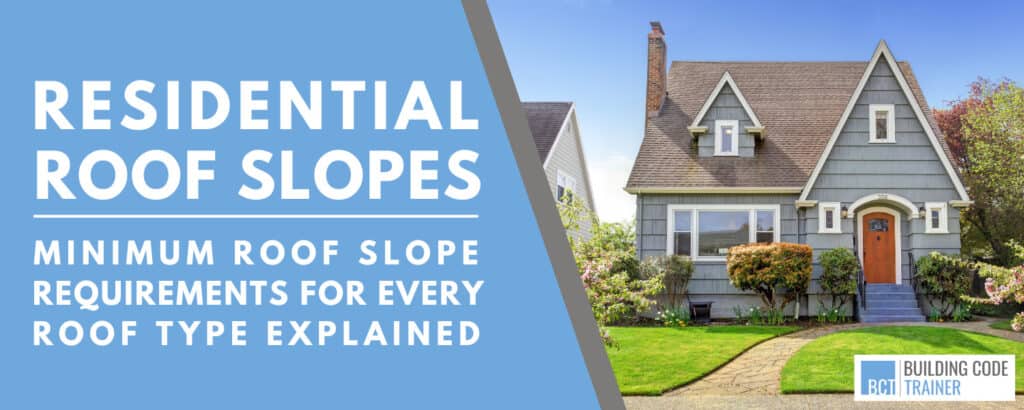Author : Building Code Trainer

The design and construction of roof assemblies for residential structures are found in Chapter 9 of the International Residential Code (IRC). As for buildings subject to the International Building Code (IBC), the roof assembly requirements are found in Chapter 15.
Fun Tip: To learn the difference between the International Residential Code (IRC) verses the International Building Code (IBC), be sure to check out this POST.
In this post we will look at the requirements in Chapter 9 of the 2021 International Residential Code (IRC), specifically Section R905 which regulates roof covering materials.
There are many different types of roof covering materials used on residential roofs of residential construction. Roof covering materials provide weather protection and Chapter 9 regulates the minimum required slope for each type of roof covering material since part of the performance of a roof covering material is based on the slope of your roof surface.
When the roof surface has less of a slope, water drainage tends to be slow so the potential of water intrusion increases since there is a greater potential for water to backup under the roofing material.
Therefore each type of roofing material has a minimum slope requirement that must be maintained to decrease the potential of water intrusion. The steeper the roof slope, the less potential for water to backup.
However the roofing materials established in Chapter 9 must meet the minimum slope requirement for each material type. This is one of the benefits of having a steep roof, especially during heavy rains.
Roof Pitch or Roof Slope?
First off lets get an understanding of the terminology that is used.
When referring to roofs, should we use the term “Pitch” or “Slope”?
Both these terms work interchangeably and basically mean the same thing however since we are referencing the code related to roofs, the code uses the term “Slope”.
You will see these examples as we go through explaining the topic of roof slopes as referenced in the code.
Minimum Roof Pitch by Roofing Material
Now lets get into the minimum roof slope requirements based on the different types of roof coverings.
Section R905 regulates many different types of roof covering materials used in residential construction. Here is a list of the roofing materials regulated by the 2021 International Residential Code:
- Asphalt Shingles
- Clay and Concrete Tile
- Metal Roof Shingles
- Mineral-Surfaced Roll Roofing
- Slate and Slate-type Shingles
- Wood Shingles
- Wood Shakes
- Built-Up Roofs
- Metal Roof Panels
- Modified Bitumen Roofing
- Thermoset Single-ply Roofing
- Thermoplastic Single-ply Roofing
- Sprayed Polyurethane Foam Roofing
- Liquid-applied Roofing
- Photovoltaic (PV) Modules/Shingles
- BIPV Roof Panels
Now let us look at the minimum roof pitch (roof slope) required for each type of roofing material regulated in the IRC.
1. Asphalt Shingles
Per Section R905.2.2, Asphalt shingles can only be installed on roof slopes of 2:12 or greater. This means for every 12 horizontal units, the roof must rise a minimum of 2 vertical units.
Also if Asphalt shingles are installed on a roof slope of 2:12 to 4:12, it shall be provided with a double underlayment application. This means that if an asphalt roof is greater than 4:12, it only requires one layer of underlayment.
This is one of the benefits of steeper roofs. Also it is important to note that a shingle roof is a very commonly used roofing material.
2. Clay and Concrete Tile
Per Section R905.3.2, Clay tiles and concrete roof tiles can only be installed on roof slopes of 2-1/2:12 or greater. This means for every 12 horizontal units, the roof must rise a minimum of two and one-half vertical units.
Also if Clay and Concrete roof tiles are installed on a roof slope of 2-1/2:12 to 4:12, it shall be provided with a double underlayment application.
3. Metal Roof Shingles
Per Section R905.4.2, Metal shingles can only be installed on roof slopes of 3:12 or greater (25% slope). This means for every 12 horizontal units, the roof must rise a minimum of 3 vertical units.
4. Mineral-Surfaced Roll Roofing
Per Section R905.5.2, Mineral-Surfaced Roll Roofing can only be installed on roof slopes of 1:12 or greater (8% Slope). This means for every 12 horizontal units, the roof must rise a minimum of 1 vertical unit.
5. Slate Shingles
Per Section R905.6.2, Slate Shingles can only be installed on roof slopes of 4:12 or greater (33% Slope). This means for every 12 horizontal units, the roof must rise a minimum of 4 vertical units.
6. Wood Shingles
Per Section R905.7.2, Wood shingles can only be installed on roof slopes of 3:12 or greater (25% slope). This means for every 12 horizontal units, the roof must rise a minimum of 3 vertical units.
7. Wood Shakes
Per Section R905.8.2, Wood shakes can only be installed on roof slopes of 3:12 or greater (25% slope). This means for every 12 horizontal units, the roof must rise a minimum of 3 vertical units.
8. Built-Up Roofs
Per Section R905.9.1, Built-Up Roofs must have a design roof slope of 1/4:12 or greater (2% slope). This means for every 12 horizontal units, the roof must rise a minimum of one-fourth vertical unit.
Coal-tar Built-up roofing material however can have a design roof slope of 1/8:12 (1% percent), but no less. This means for every 12 horizontal units, the roof must rise a minimum of one-eighth vertical unit.
A built-up roof material is ideal for low-slope roofs. With a minimum 1-2% slope, these types of roofs are typically considered a flat roof.
9. Metal Roof Panels
Per Section R905.10.2, the minimum roof slope of metal roofing panels depend on 3 different scenarios.
- Lapped, nonsoldered-seam metal roofs without applied lap sealant must have a minimum roof slope of 3:12 (25% slope). This means for every 12 horizontal units, the roof must rise a minimum of 3 vertical units.
- Lapped, nonsoldered-seam metal roofs with applied lap sealant must have a minimum roof slope of 1/2:12 (4% slope). This means for every 12 horizontal units, the roof must rise a minimum of one-half vertical unit.
- Standing-seam roof systems must have a minimum roof slope of 1/4:12 (2% slope). This means for every 12 horizontal units, the roof must rise a minimum of one-quarter vertical unit.
10. Modified Bitumen Roofing
Per Section R905.11.1, Modified bitumen membrane roofs must have a design roof slope of 1/4:12 or greater (2% slope). This means for every 12 horizontal units, the roof must rise a minimum of one-fourth vertical unit.
With a minimum 2% slope, this is considered a low slope roof.
11. Thermoset Single-ply Roofing
Per Section R905.12.1, Thermoset Single-ply membrane roofs must have a design roof slope of 1/4:12 or greater (2% slope). This means for every 12 horizontal units, the roof must rise a minimum of one-fourth vertical unit.
12. Thermoplastic Single-ply Roofing
Per Section R905.13.1, Thermoplastic Single-ply membrane roofs must have a design roof slope of 1/4:12 or greater (2% slope). This means for every 12 horizontal units, the roof must rise a minimum of one-fourth vertical unit.
13. Sprayed Polyurethane Foam Roofing
Per Section 905.14.1, Sprayed Polyurethane Foam roofs must have a design roof slope of 1/4:12 or greater (2% slope). This means for every 12 horizontal units, the roof must rise a minimum of one-fourth vertical unit.
14. Liquid-Applied Roofing
Per Section R905.15.1, Liquid-applied roofing must have a design roof slope of 1/4:12 or greater (2% slope). This means for every 12 horizontal units, the roof must rise a minimum of one-fourth vertical unit.
15. Photovoltaic Shingles
Per Section R905.16.2, Photovoltaic shingles can only be installed on roof slopes of 2:12 or greater. This means for every 12 horizontal units, the roof must rise a minimum of 2 vertical units.
16. BIPV Roof Panels
BIPV roof panels stand for building-integrated photovoltaic roof panels which are applied directly to the roof deck. Per Section R905.17.2, BIPV roof panels can only be installed on roof slopes of 2:12 or greater. This means for every 12 horizontal units, the roof must rise a minimum of 2 vertical units.
Roof Pitch Calculator
Looking for a simple roof pitch calculator? Try out the one below.
Just enter the rise and run in either inches or feet and the results will provide you with the pitch, degrees, and percentage of the roof slope.
Roof Pitch Calculator
Disclaimer: This calculator is intended for educational purposes only. The number generated is based on information provided by the user. The user of this training material assumes all risks as to its accuracy.
Final Thoughts
Therefore if you are installing a specific roofing material that is regulated by the International Residential Code (IRC), make sure the pitch of your roof has the minimum required roof slope for the type of roofing material being used.
Let us recap on the minimum roof pitch required for each type of roofing material:
- Asphalt Shingles require a minimum roof pitch of 2:12 or greater.
- Clay and Concrete Tile requires a minimum roof pitch of 2-1/2:12 or greater.
- Metal Roof Shingles require a minimum roof pitch of 3:12 or greater.
- Mineral-Surfaced Roll Roofing requires a minimum roof pitch of 1:12 or greater.
- Slate and Slate-type Shingles require a minimum roof pitch of 4:12 or greater.
- Wood Shingles require a minimum roof pitch of 3:12 or greater.
- Wood Shakes require a minimum roof pitch of 3:12 or greater.
- Built-Up Roofs require a minimum roof pitch of 1/4:12 or greater. As for Coal-tar Built-up roofs, they can be installed on a roof pitch of 1/8:12 or greater.
- Metal Roof Panels:
- Lapped, nonsoldered-seam metal roofs without applied lap sealant must have a minimum roof slope of 3:12.
- Lapped, nonsoldered-seam metal roofs with applied lap sealant must have a minimum roof slope of 1/2:12.
- Standing-seam roof systems must have a minimum roof slope of 1/4:12.
- Modified Bitumen Roofing requires a minimum roof pitch of 1/4:12 or greater.
- Thermoset Single-ply Roofing requires a minimum roof pitch of 1/4:12 or greater.
- Thermoplastic Single-ply Roofing requires a minimum roof pitch of 1/4:12 or greater.
- Sprayed Polyurethane Foam Roofing requires a minimum roof pitch of 1/4:12 or greater.
- Liquid-applied Roofing requires a minimum roof pitch of 1/4:12 or greater.
- Photovoltaic (PV) Modules/Shingles require a minimum roof pitch of 2:12 or greater.
- BIPV roof panels require a minimum roof pitch of 2:12 or greater.
Related Articles to Read:
- What Is A Drip Edge On The Roof and When Is It Required?
- What Is The Rake of a Roof? | Explained!
- How to Calculate Attic Ventilation Requirements? (Explained)
About the Author

Building Code Trainer
AuthorThis site is run and maintained by a Certified Building Official, Plans Examiner, and Inspector. With a Bachelors of Science Degree in Construction Engineering along with holding multiple ICC certifications, the Author of this site has over 15 years of experience within the construction industry.
